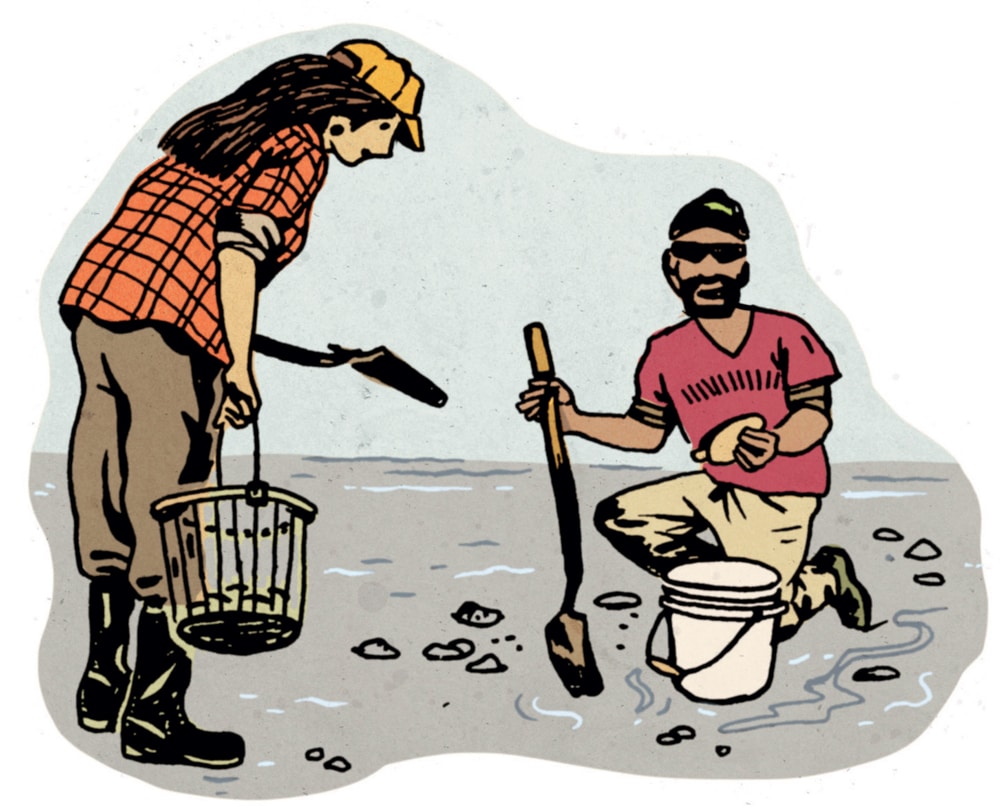
Building Sandcastles
Photo Credit : Illustration by John S. Dykes
Photo Credit : Illustration by John S. Dykes
Pro Tips:Building Sand Castles
Advice from Greg Grady, founder of the Sand Sculpting Competition at New Hampshire’s Hampton Beach, on how to become a master builder.
♦ The Right Stuff: Head to the water’s edge, pick up a handful of sand, and form a ball. “If you can hold it sideways between your thumb and middle finger and it stays compacted,” Grady says, “you can sculpt that sand.”
♦ Patty-Cake, Patty-Cake: Grady is a big proponent of building via pancake method. You need a “mud bucket,” a container filled two-thirds with sand and mixed with water for a batter-like consistency. Fill, dump, shape, then repeat. “Pat [the pancakes] down so they’re nice and flat,” Grady advises.
♦ Form & Function: For a simple tower, Grady recommends a five-gallon bucket with the bottom removed. Turn it upside down, fill it with sand and water, and pound it firm. To release the bucket, tap the sides gently and lift. For a tapered construction, continue building with smaller and smaller containers.
♦ Get Sticky: “What really hurts a sculpture are wind and blowing sand,” Grady says. To keep your creations well hydrated, spritz them with a spray bottle—which doubles as a handy cooler for you, too.

Photo Credit : Illustration by John S. Dykes
How toKeep Seagulls from Eating Your Lunch
The perfect beach day: sea, blue sky, fully loaded picnic basket. Or perhaps you’ve carried a lobster roll from fish shack to outdoor table, ready to enjoy. Then, a flash of wings, a snapping beak, and you’re staring at the empty plate. You just bought a seagull lunch.
Anyone who has spent time by the ocean has a tale of the meal that got away. You laugh, you fume, you wonder, What can I do? Experts offer these tips:
♦ Because gulls often dive-bomb from behind, eat with your back to a wall, eyes skyward.
♦ Never toss a bit of food to one gull. That just signals “Come and get it” to dozens more.
♦ Carry a kiddie water gun to surprise uninvited guests with a quick spray that says, “Back off!”
♦ To protect from air raids, eat beneath a beach umbrella.
♦ Look seagulls in the eye. Researchers have found that the cheeky birds back away when stared at.
♦ If all else fails, you can try what one New Jersey beach town did: bring in trained birds of prey to circle overhead and scare them off.

Photo Credit : Illustration by John S. Dykes
Clamming for Beginners
One of the most satisfying ways to enjoy the sea is to head out at low tide, clam rake in hand, ready to gather a fresh ocean bounty. Here are basics for a safe, fun, and legal outing.
1. Check with the local town hall to find out when clamming is allowed and how to buy a recreational shellfish license. Ask about size regulations, which may vary from 1- to 2-inch minimums to insure sustainability.
2. Low tide is optimal for clamming, though an hour or two on either side will still offer a good chance at filling your bucket.
3.You’ll want a clam rake, a wire clam basket, and a clam gauge—all available online or at bait-and-tackle shops. Rubber boots and gloves will protect feet and hands from sharp shells.
4. Keep clams cool and alive before cooking, on ice or in the fridge. Enjoy fresh!

Photo Credit : Illustration by John S. Dykes
Pro Tips: Flying a Kite
Beaches may be idealkite-flying territory, but to really hit the heights, your choice of kite is crucial. Robert Foster, owner of Dr. Gravity’s Kite Shop in Harwich Port, Massachusetts, recommends a parafoil-style kite, which he describes as “the most versatile, with no moving parts other than the line, and easy to fly in low or high wind.”
Foster also advises knowing which way the wind is blowing. In summer, prevailing winds are from the south, so “flying on Cape Cod’s north shore is great—your kite will fly high over land,” he says. “But on the south shore, depending on the tide, your kite will be over water.” (Which means that if swimming wasn’t on your agenda, it might well be now.)

Photo Credit : Illustration by John S. Dykes
3 Beachy Apps to Tap
♦Sharktivity: Want to keep tabs oncertain seasonal visitors to New England—from a distance? This app from the Atlantic White Shark Conservancy lets you track shark movements off Cape Cod and beyond, stay up to date on beach alerts, and even take on the role of citizen scientist by logging your own sightings.Free; iOS and Android.
♦Windfinder: Begun more than 20 years ago as a simple SMS-based forecast service, Windfinder today is a sleek, info-packed app powered by a global network of 21,000 weather stations. Perfect for sailors, surfers, kite enthusiasts, or sun worshippers wondering if their beach umbrella will be blown away.Free, paid pro version available; iOS and Android.
♦UVIMate: Bask secure knowing that this “personal sun safety coach” has you covered with UV forecasts, personalized SPF recommendations, and sunscreen application reminders. Works for smart watches, too. Free, paid upgrades available; iOS and Android.

Dressingfor Success
Looking to take more than a quick dip in the Atlantic? As any New England surfer will tell you, a bit of neoprene can go a long way.
HAMMONASSET BEACH (CT)
Average water temperature in August: 73°F Wetsuit thickness: 0.5mm–2/1mm Wetsuit type: Neoprene top
MISQUAMICUT BEACH (RI)
Average water temperature in August: 70°F Wetsuit thickness: 2mm–3/2mm Wetsuit type: Shorty or springsuit
COAST GUARD BEACH (MA)
Average water temperature in August: 66°F Wetsuit thickness: 2mm–3/2mm Wetsuit type: Shorty or springsuit
OLD ORCHARD BEACH (ME)
Average water temperature in August: 64°F Wetsuit thickness: 2mm–3/2mm Wetsuit type: Full
How to Handle 3 Beach Hazards
Sunburns
Too much sun exposure will not only have you feeling the burn but also increase your risk for skin cancer. Choose a broad-spectrum sunscreen with a sun protection factor of at least 30 (SPF 30 filters out 97 percent of UV rays; SPF 50, 98 percent). Sunscreens are never truly sweat- or waterproof, so for best protection, reapply every two hours.
Greenhead Flies
While we don’t begrudge greenhead flies their love of the beach, we do object to being their favorite snack. They ignore most repellents (Avon Skin-So-Soft annoys them, at least) but can’t bite through clothing, so bring extra layers for covering up. Some beaches post seasonal greenhead warnings—heed them.
Rip Currents
Powerful and unpredictable swaths of water that surge away from land, rip currents—which are responsible for an estimated 80 percent of lifeguard rescues—can sweep away even the best swimmers. If caught in a rip current, don’t try to swim directly to shore; that’s the fastest route to exhaustion. Instead, swim parallel to shore to escape the stream.


